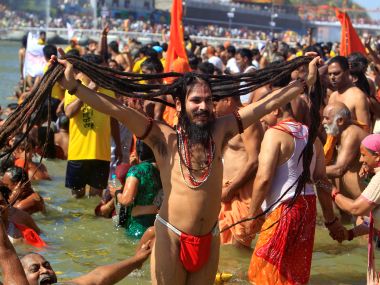Like a microcosm of India, Mahakumbh Mela, the largest congregation of Hindus held every twelve years on the banks of holy rivers in Haridwar, Prayag (Allahabad), Nashik and Ujjain, riddled with paradoxes. And central to this is the institution of akharas, organized groups of militant Hindu ascetics, formed to defend Hinduism against ‘heretical religions’ of foreign invaders. As Ujjain Sinhastha ended on Saturday with Shahi Snan (Royal Bath) by the 13 recognized akharas, it once again underlined this fundamental paradox of Hindu social order. These high priests of Hinduism, who are supposed to have renounced worldly goods, are fighting among themselves for power and pelf. The Simhastha at Ujjain started last with a strong protest from three Vaihsnavite akharas against Madhya Pradesh government’s decision to recognized Mahant Narendra Giri as president of the Akhil Bharatiya Akhara Parishad (ABAP), the apex organisation of Sikh and Hindu militant ascetics. Giri belongs to Shaivite Nirnanjani Akhara and supporters of his rival Mahant Gyandas of Vaishnavite Nirvani Ani Akhara (Vaishnav) have challenged his election in the Allahabad High Court. While the rivalry between the Vaishnavite and Shaivite dates several centuries back and has seen many violent clashes at previous Kumbh melas, there has been a spurt in clashes among various factions within the akharas of late. The month-long mela at Ujjain this time witnessed a bloody clash between two factions during election of the Sri Mahant of Ahvahan Akhara, a Varanasi-based Shavite outfit in which fire arms were used. A similar clash between two groups was reported in the Dutt Akhara, another Shavite outfit. The Vaishnavite akharas, which had split into two factions during Vishwa Hindu Parishad’s Ayodhya movement in the late eighties and early nineties, continue to simmer with inner squabbles. [caption id=“attachment_2745646” align=“alignleft” width=“380”]  Representational image. Reuters[/caption] A powerful group within the Nirmohi Ani Akhara, for instance, is challenging Mahant Rajendradas’s claim to be recognized as Sri Mahant of the akhara. “He has misled the mela administration in collusion with the self-styled president of the Akhara Patrishad, Narandra Giri,” alleges Mahant Paramatma Das. Rajendradas belongs to Shyamanadiya Nirmohi Akhara while his rivals represent Ramanandiya Nirmohi Akhara. On records all the prominent akhara leaders deny existence of caste as a factor in contemporary Sadhu politics. This was reflected in the sharp reactions from Shankaracharya Swaroopanand and Akhara Parishad president Narendra Giri to the BJP’s attempt to organise Shabri Kumbh at the Simhastha to woo Dalit and lower castes. Despite their claim that a Sadhu doesn’t have any caste and any attempt to devide them on caste lines could prove dangerous, social historians maintain that caste has played a key role in evolution of the akharas since Mughal period. “Hindu ascetics have played an important role in shaping Hindu thought and social order since early times, but the role itself has changed over the passage of time,” says Robert Lewis Cross in his monumental study of Hindu asceticism titled The Sadhus of India. Though they differ over the origin of the institution, most historians agree that the first major attempt to organize them into Akharas was made by the first Shankaracharya (8th century AD), who established ten Shavite to defend Hinduism against the challenge of Buddhism and Jainism. The Vaishnavite groups with similarly structured Akharas appeared after Ramanuja in the 11th and 12th centuries. These proliferated after emergence of Ramanandi sects 13th century onwards that opened up gates of Hindi religious order to low Shudra castes. According to pioneering Indian sociologist GS Ghurye, “militant asceticism began to depart from its strict orientation of world negation in 13th and 14 centuries to become more politically responsive and military active in defending Hinduism from the onslaughts of Islam.” Robert Lewis Cross thinks the change was based on a policy of competitive territorial acquisition and arrogation of economic and political power. “Its suppression by the British in 18th and 19th century influenced the character of medieval and, ultimately, contemporary ascetic organization,” he writes in The Sadhus of India. Along with Muslim fakirs, the militant Sadhus formed to the first wall of resistant against British colonialism. While ruthlessly repressing their militancy, the British adopted a policy of carrot and stick with the akhara heads and this policy was continued by the Congress governments after the transfer of power in 1947. While the bargaining for power and pelf between the Indian sadhus and the ruling political establishment continued behind the stage, the first overt attempt to use them as a tool for political mobilisation of the Hindus was made by the RSS saffron brigade during the Ayodhya movement to capture power in Uttar Pradesh in 1991. But the demolition of the Babri mosque and post 1993 developments made it realise that caste — one of the basic features of Hindu social organization — presents a major road block in its path. Now that Narendra Modi has managed to capture power at the Centre and elections for Uttar Pradesh state assembly are due within a few months, the BJP is going all out to break this barrier by roping in the Sadhus from lower castes and Ujjain Simhastha is its latest experiment in that direction.
Mahakumbh Mela, the largest congregation of Hindus held every twelve years on the banks of holy rivers in Haridwar, Prayag (Allahabad), Nashik and Ujjain, riddled with paradoxes.
Advertisement
End of Article


)
)
)
)
)
)
)
)
)



